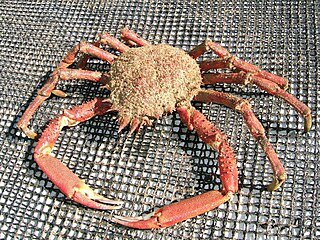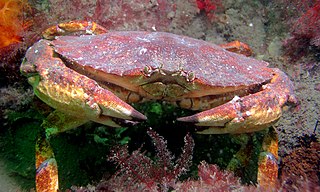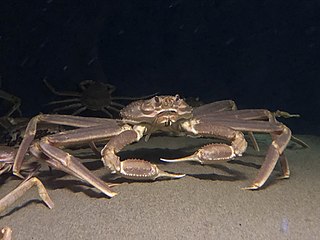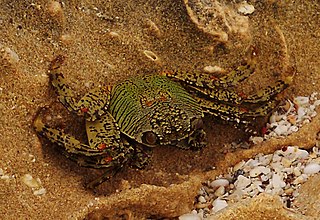
The Dungeness crab is a species of crab inhabiting eelgrass beds and water bottoms along the west coast of North America. It typically grows to 20 cm (7.9 in) across the carapace and is a popular seafood. Its common name comes from Dungeness Spit, United States, which shelters a shallow bay inhabited by the crabs.

Jasus edwardsii, the southern rock lobster, red rock lobster, or spiny rock lobster, is a species of spiny lobster found throughout coastal waters of southern Australia and New Zealand including the Chatham Islands. It is commonly called crayfish in Australia and New Zealand and kōura in Māori. They resemble lobsters, but lack the large characteristic pincers on the first pair of walking legs.

Cancer pagurus, commonly known as the edible crab or brown crab, is a species of crab found in the North Sea, North Atlantic Ocean, and perhaps the Mediterranean Sea. It is a robust crab of a reddish-brown colour, having an oval carapace with a characteristic "pie crust" edge and black tips to the claws. A mature adult may have a carapace width up to 25 centimetres and weigh up to 3 kilograms. C. pagurus is a nocturnal predator, targeting a range of molluscs and crustaceans. It is the subject of the largest crab fishery in Western Europe, centred on the coasts of the British Isles, with more than 60,000 tonnes caught annually.

Cancer is a genus of marine crabs in the family Cancridae. It includes eight extant species and three extinct species, including familiar crabs of the littoral zone, such as the European edible crab, the Jonah crab and the red rock crab. It is thought to have evolved from related genera in the Pacific Ocean in the Miocene.

Metacarcinus anthonyi, the yellow rock crab or yellow crab, is a species of edible crab native to the Pacific coast of North America.

The Jonah crab is a marine brachyuran crab that inhabits waters along the east coast of North America from Newfoundland to Florida. Jonah crabs possess a rounded, rough-edged carapace with small light spots, and robust claws with dark brown-black tips. The maximum reported carapace width for males is 222 mm, while females rarely exceed 150 mm. It is the closest relative to the European brown crab in the Western Atlantic.

Maja squinado is a species of migratory crab found in the north-east Atlantic and the Mediterranean Sea. The appearance of the European spider crab is similar to the much larger Japanese spider crab.

Hemigrapsus sexdentatus, also called the “common rock crab” or “common shore crab,” is a marine crab indigenous to the southern shores of New Zealand. This crab is a member of the Varunidae family in the order Decapoda.

The smooth shore crab is a marine large-eyed crab of the family Grapsidae, found in New Zealand and the Juan Fernández Islands of Chile.

Ovalipes catharus, commonly known as paddle crab and Māori: pāpaka, is a species of crab of the family Portunidae. It is found around the coasts of New Zealand, the Chatham Islands, and in south-eastern parts of Australia. Individuals from shallow waters, 0.1–0.5 metres (4–20 in) deep, have a carapace width of only 10–15 millimetres (0.4–0.6 in), while those from 5–15 m (16–49 ft) are 100–140 mm (3.9–5.5 in) wide.

Cancer productus, one of several species known as red rock crabs, is a crab of the genus Cancer found on the western coast of North America. This species is commonly nicknamed the Pearl of the Pacific Northwest.

Paralithodes platypus, the blue king crab, is a species of king crab from cold waters in the North Pacific Ocean and adjacent seas. Although blue king crabs are among the largest crabs in the world and reputedly may exceed 18 pounds (8.2 kg) in weight, they are generally smaller than red king crabs.

Metacarcinus is a genus of crabs formerly included in the genus Cancer. It includes nine exclusively fossil species and five extant species, of which four are also known from the fossil record. A molecular study using the cytochrome oxidase I gene does not support the monophyly of this genus.

Chionoecetes opilio, a species of snow crab, also known as opilio crab or opies, is a predominantly epifaunal crustacean native to shelf depths in the northwest Atlantic Ocean and north Pacific Ocean. It is a well-known commercial species of Chionoecetes, often caught with traps or by trawling. Seven species are in the genus Chionoecetes, all of which bear the name "snow crab". C. opilio is related to C. bairdi, commonly known as the tanner crab, and other crab species found in the cold, northern oceans.
Hypothalassia acerba is a large crab found in the muddy substrates of the deep seas off the southwestern Australian and New Zealand coasts. Australian distribution, which is correlated to depth and temperature, ranges from a latitude as far north as approximately 27° S on the west coast, southwards, then eastwards on the south coast to a longitude of at least 129° E. The species usually occurs in waters with temperatures of 13–19 °C (55–66 °F) and in depths ranging of 200–255 metres (656–837 ft) on the lower west coast and 90–200 m (300–660 ft) on the south coast. Body size is inversely related to depth of water. There are only two species in the genus Hypothalassia, and H. acerba is not the same champagne crab as the other Hypothalassia species, H. armata, which is found in Japanese waters.

Dyspanopeus sayi is a species of mud crab that is native to the Atlantic coast of North America. It has also become established outside its native range, living in Swansea Docks since 1960, the Mediterranean Sea since the 1970s, the North Sea since 2007 and the Black Sea since 2010. It can reach a carapace width of 20 mm (0.8 in), and has black tips to its unequal claws. It feeds on bivalves and barnacles, and is in turn eaten by predators including the Atlantic blue crab, Callinectes sapidus. Eggs are produced from spring to autumn, the offspring reach sexual maturity the following summer, and individuals can live for up to two years. The closest relative of D. sayi is D. texanus, which lives in the Gulf of Mexico; the two species differ in subtle features of the genitalia and the last pair of walking legs.
Jasus frontalis, known as the Juan Fernández rock lobster, is a species of spiny lobster in the genus Jasus, found around the Juan Fernández and Desventuradas Islands in the south-eastern Pacific Ocean.
The Red-claw mangrove crab is a crab species in the genus Parasesarma and the family Sesarmidae. It is distributed in coastal brackish water habitats of the western Indian Ocean.

Grapsus albolineatus is a species of decapod crustacean in the family Grapsidae, native to the Indo-Pacific.

Hepatus pudibundus, the flecked box crab, is a crab from the class Malacostraca. They are found in the Atlantic Ocean with Brazil having a dense population of H. pudibundus, as they are one of the most commonly seen crabs in the country. Many of the studies done on H. pudibubus have occurred in the Ubatuba region of Brazil, where there is a rapid expansion of tourism that is affecting marine ecosystems.



















